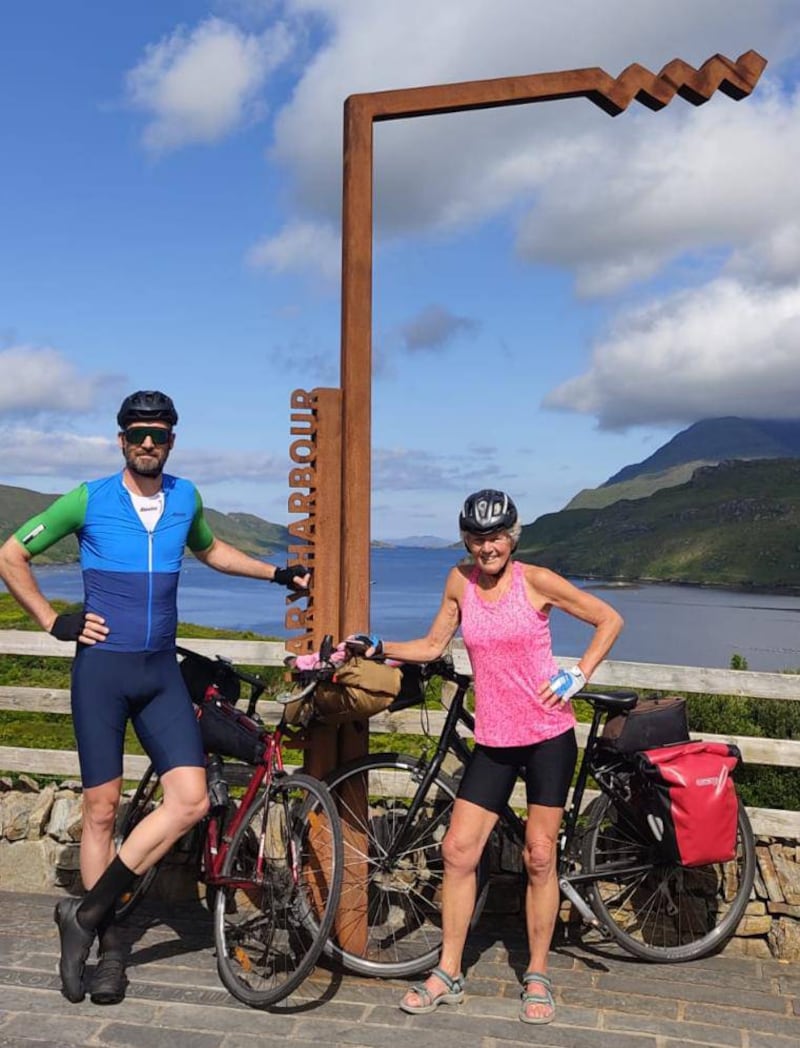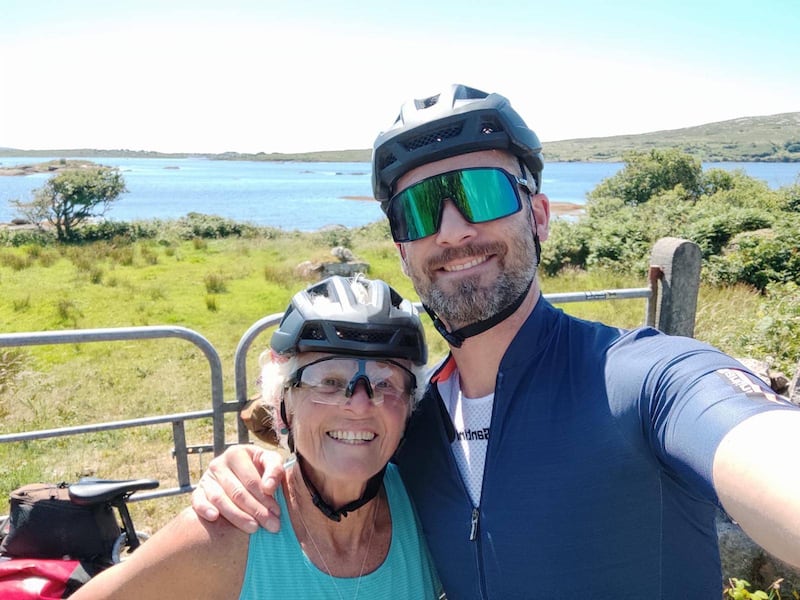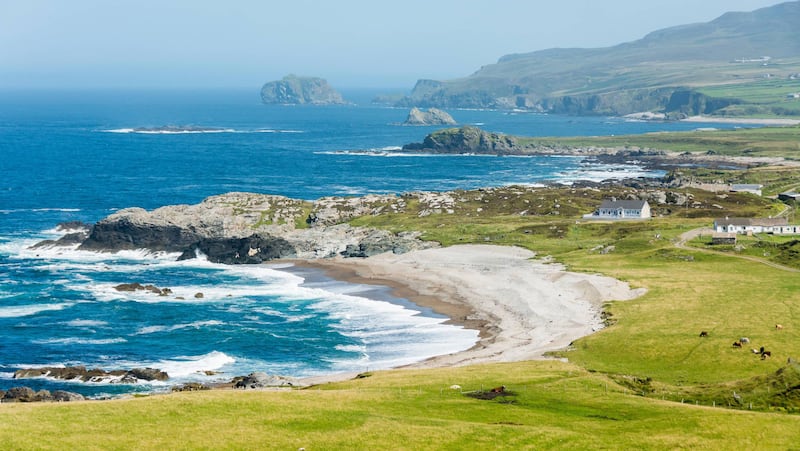The Wild Atlantic Way celebrates its tenth anniversary this year, so there’s never been a better time to plan your visit on the world’s longest defined coastal touring route. Spanning nine counties along Ireland’s Atlantic coast, the 2,600 km (1,600 mile) legendary road trip takes in numerous spectacular landscapes, including wind whipped wildernesses, glorious secluded beaches, castles, light houses and historic monuments.
Once neglected towns and villages are also reborn thanks to road signs with the distinctive wavy WAW logo, an ingenious concept devised by Failte Ireland to embrace what was already there. Staring us in the face was our country’s natural beauty and those forgotten or ignored corners overshadowed by famous existing jewels in the crown along the western seaboard.
Orla enjoys keeping the tradition of reuniting each summer with her Brussels-based son Colm for their cycles.

Lonely Planet recently named Keem Bay on Achill Island one of the 100 best beaches in the world at the end of a “jaw-droppingly beautiful drive”. The accolades keep on coming from international travel publications, reviews, blogs, vlogs and reels on social media enticing tourists from all over the world to experience Ireland’s epic coastal route.
READ MORE
National Geographic Traveller told readers recently “The Wild Atlantic Way has become one of Europe’s most exciting road trips, not least because it ticks off some of Ireland’s most memorable experiences … It’s celebrating its 10th anniversary in 2024, and a string of new experiences along its route means there’s more to enjoy than ever.”
The route, passing through three provinces, officially starts from Co Donegal’s Inishowen Peninsula and ends in Kinsale Co Cork, but just as many travellers decide to begin their journey in the opposite direction following the coast north. Failte Ireland divided the route into six regions, reflecting the changing landscape of our western coast. The Haven Coast features the inlets and magical coves from Kinsale to Bantry Bay and the Gulf Stream. The South West features the awesome scenery around the peninsulas of Cork and Kerry. The Cliff Coast dubbed ‘Hard land, warm heart’ runs from north Kerry to Clare and up to Galway. The Bay Coast, including huge swathes of pristine beach fringed by Connemara’s remote moorland, stretches to the magnificent wild Erris Beo in Mayo. The Surf Coast winds up from Erris through Sligo’s beautiful Yeats country to Donegal. Finally, the Northern Headlands, untouched and virtually empty, are dominated by the dizzying heights of Sliabh Liag, Europe’s highest sea cliffs.
Passing through mountain wildernesses, descending to secluded beaches and bays, winding along country roads, sheer cliffs, historic sites and child friendly attractions with stops in quaint villages for a cuppa or a foray into a proper town, the Wild Atlantic Way has something to offer every visitor, young and old.
A week can take you with motorised transport along the routes but you cut corners and two weeks is more realistic. A lovely, more inclusive option is to follow the Wild Atlantic Way in stages at different times of the year or continuing where you broke off later. If you are hiking or cycling, with oodles of time to stop and enjoy all the ancient history, sweeping vistas and warm hospitality, the Wild Atlantic Way turns into a truly epic journey.
It is one that Orla Mhic Athlaoich and her son Colm have been enjoying for five years (not counting years lost through COVID) cycling up the Wild Atlantic Way, covering 500 km during each week long adventure every July. “Luckily we still have a few more years to go, taking in Sligo and Donegal; I never want this wonderful journey to end”, Orla reveals. The super active retired teacher in her seventies also values time together with her only son, Brussels based Colm Mac Athlaoich (43).
Her bible ‘Exploring Ireland’s Wild Atlantic Way’ by David Flanaghan and Richard Creagh has excellent route advice for cyclists. “I always train on my bike doing up to 100 km a week beforehand; you have to be fit to undertake long distance cycle trips, some of the terrain is hilly and steep; the wind at times can be punishing on the bike, it was a big challenge but one I’ve enjoyed so much”, she says.

“The freedom is unbelievable, packing all you need into the side panniers and away you go for the week; popping off the bike for a chat with people, a dip in the sea or to explore an interesting landmark down a side road. These are pleasures you enjoy when you’re cycling. Everywhere we went people were fascinated by this old woman and young man….what’s going on….I could almost hear them thinking…. wondering if maybe he’s her toy boy!”
Mother and son embarked on their first leg of the Wild Atlantic Way from Orla’s doorstep outside Kinsale. A nostalgic family link also drew them towards the epic journey. Peadar OhAnnrachain, Orla’s grandfather cycled down the entire western seaboard from Donegal home to west Cork back in 1909. An early pioneer of the famous coastal route he was collecting social history for the book he wrote ‘Mar chonnach-sa Éire (As I saw Ireland). Colm hopes later to create a body of art work connecting their own journey with the Ireland his great grandfather saw in the early days of the 20th century.
Orla and Colm have religiously taken the official route pedalling up to 100 km a day, and they have visited most of the islands, Sherkin and Cape Clear in West Cork, Skellig “the most incredible place” Co Kerry, the Aran Islands of Inis Oirr and Inis Meain, Clare Island and Inishbofin. They’ve also stopped at all the lighthouses. Orla’s senior free travel pass gave her free passage on boats to the islands but she had to pay for the bike.
Highlights over the years of the Wild Atlantic Way have been so many that Orla says nothing so far has ever underwhelmed her, although travelling during high summer they didn’t tarry at the Gap of Dunloe, Killarney, Dingle and Cliffs of Moher, crowded to bursting point with tour buses, cars and tourists.
“But I don’t have a problem with that, it was great to see people enjoying themselves, loving our country, it just wasn’t what we were looking for. What stands out are unique experiences like being on the old rattling cable car crossing Dursey Sound, West Cork; we were so in awe of the beauty and other worldliness there and also on the other islands. As Irish speakers we were in our element also in the Gaeltacht chatting to all we met. We’re proud to say we rescued two sheep stuck in bog holes, once in Kerry and again in Connemara. It took a lot of effort to lift them out; they shook themselves off all over us and ran off leaving us filthy but so happy.”
Recalling their journey in July 2023 Orla says she was unexpectedly enthralled by parts of Mayo, especially Downpatrick Head and the Ceide fields of prehistoric tombs. “When we got to North Mayo and Ceathru Thaidhg the scenery was outstanding, so unspoilt; that day was a really hard cycle of 100 km through tough weather and wind but well worth it in the end.” Wilderness Ballycroy National Park, famous for its unpolluted night skies, was another highlight.
The final stretch of Orla and Colm’s cycle will be from Malin Head in Donegal (pictured) to the last section just north of the city of Derry.

Further south, misty rain was blanketing Achill, so Orla and Colm dismounted and took shelter in a warm café where they met “foreigners who were loving our soft weather and that rain mist; we were apologising and they were saying they loved it”.
Interestingly, the pair discovered that prices have not increased significantly over the years and budgeting for the week long July trips are unchanged, perhaps cheaper accommodation in one place and a little more expensive in another. They rewarded themselves every evening by dining out in the best nearby restaurants they could find experiencing “food and cooking that has come on by leaps and bounds every year”.
Next year’s stage of the Wild Atlantic Way takes them further north to Sligo, followed by Donegal with its huge coastline by 2025. Orla predicts that it may take a further three years before they pedal from Malin Head to the last section just north of the city of Derry — at least that’s what she hopes. “We don’t want to rush it, why would you when you’re enjoying the joyride so much”.
* If you want to avoid crowds, then going during spring and autumn may be better. Winter can also be a great time to drive the Wild Atlantic Way as roads and attractions will be quiet. If cycling the WAW make sure you have a good, well serviced bicycle and you are an experienced cyclist, confident on narrow roads with little or no overtaking space.















